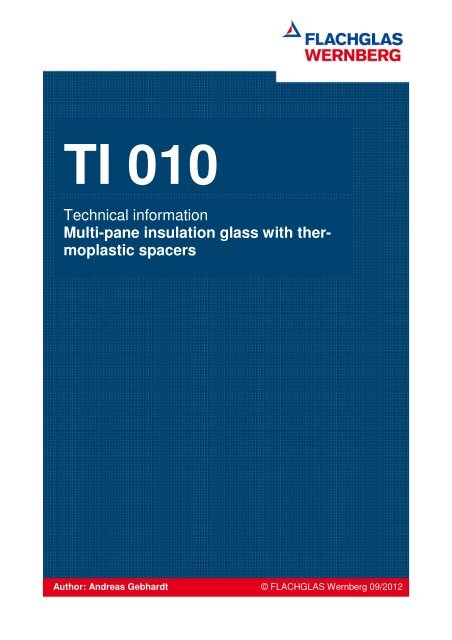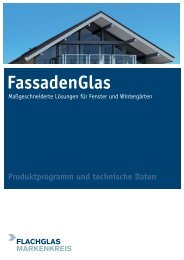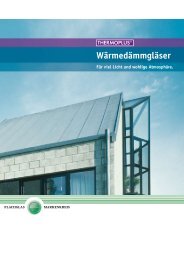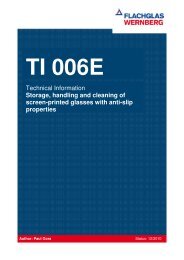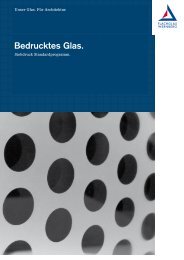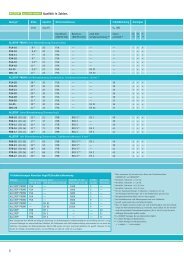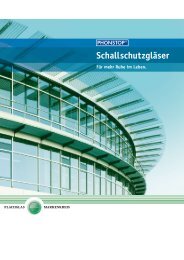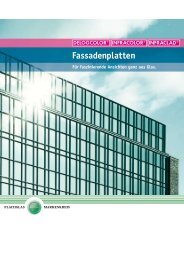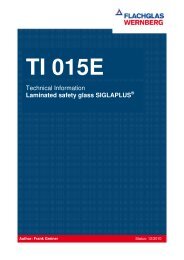TI 010 Insulated glazing with thermoplastic spacer - FLACHGLAS ...
TI 010 Insulated glazing with thermoplastic spacer - FLACHGLAS ...
TI 010 Insulated glazing with thermoplastic spacer - FLACHGLAS ...
Create successful ePaper yourself
Turn your PDF publications into a flip-book with our unique Google optimized e-Paper software.
<strong>TI</strong> <strong>010</strong>Technical informationMulti-pane insulation glass <strong>with</strong> <strong>thermoplastic</strong><strong>spacer</strong>sAuthor: Andreas Gebhardt © <strong>FLACHGLAS</strong> Wernberg 09/2012
Technical informationMulti-pane insulation glass <strong>with</strong> a <strong>thermoplastic</strong><strong>spacer</strong>CONTENTS PAGE2 IntroductionHow to use the technical informationSyntax conventions3 Subject matterDefintionsFunctionManufactureProduction- related options5 GeometryDimensioning6 Materials used in our multi-pane insulation glassMaterials used <strong>with</strong>in the <strong>glazing</strong> unitsTechnical data7 Combination options8 Areas of useVisual qualityNorms, guidelines and regulations9 References<strong>TI</strong> <strong>010</strong> © <strong>FLACHGLAS</strong> Wernberg 09/2012 Page 2 of 12
Technical informationMulti-pane insulation glass <strong>with</strong> a <strong>thermoplastic</strong><strong>spacer</strong>INTRODUC<strong>TI</strong>ONThese days there are hardly any limits to the use of multi-pane insulation glass on the exterior of buildings.Parallel to increasing technical requirements on this product, planners and constructors are being given anever increasing spectrum of possibilities for design and implementation.This technical information document is intended to provide information, ideas and help on a day to day workingbasis. It is aimed at specialist project consultants and professionals in the plate glass trade and plateglass processing industries, as well as the architectural glass block, window and structural facings constructionsectors.This technical information is regularly updated in order to take account of the product’s technical progress.HOW TO USE THE TECHNICAL INFORMA<strong>TI</strong>ONThroughout the entire document you will find comments, tips and cautionary notes intended to make youaware of particular issues that require consideration.NOTE: notes contain explanatory notes and additional information<strong>TI</strong>P: tips contain useful explanatory notesCAU<strong>TI</strong>ON: cautions contain information necessary to avert serious complicationsSYNTAX CONVEN<strong>TI</strong>ONSThe following objects are visually highlighted as follows, in order to make the document easier to read:<strong>TI</strong> XXX.pdfwww.flachglas.deFiles, paths and directories are underlined and in italics.Links to websites are marked as such.<strong>TI</strong> <strong>010</strong> © <strong>FLACHGLAS</strong> Wernberg 09/2012 Page 3 of 12
Technical informationMulti-pane insulation glass <strong>with</strong> a <strong>thermoplastic</strong><strong>spacer</strong>SUBJECT MATTERThis technical information document relates to insulating glass units in accordance <strong>with</strong> DIN EN 1279, fitted<strong>with</strong> <strong>thermoplastic</strong> <strong>spacer</strong>s, and which are manufactured by <strong>FLACHGLAS</strong> Wernberg GmbH for use in buildingsand other constructions.Please contact us <strong>with</strong> a view to product-related options, constraints, visual quality etc. if you wish to use theproduct for specific applications, such as in automobile construction, plant engineering or furniture construction.DEFINI<strong>TI</strong>ONSMulti-pane insulation glass units consist in principle of two or more panes of glass, which are separatedfrom one another by one or more air spaces between the panes of glass, such spaces being hermeticallysealed and the air <strong>with</strong>in them dried.Edge bond for insulating glass is where the relevant air space between the panes of glass is sealed offfrom its surroundings. <strong>FLACHGLAS</strong> Wernberg GmbH's edge bond has a dual seal as standard.Dual bonded edge bond for insulating glass consists of a <strong>spacer</strong> profile containing a highly effective absorber(desiccant), a flexible polyisobutyl-based sealant (butyl) and a permanently elastic secondary sealant/adhesive.One version of this model is the edge bond for insulation glass <strong>with</strong> a <strong>thermoplastic</strong> <strong>spacer</strong>.Edge bond <strong>with</strong> <strong>thermoplastic</strong> <strong>spacer</strong><strong>thermoplastic</strong> <strong>spacer</strong> as primary sealsecondary sealantSource: www.bystronic-glass.comPsi-value (Ψ-value): the linear thermal transmittance coefficient [W/(mK)] is a measure of the thermal heatbridge <strong>with</strong>in a window. It is influenced by the window frame‘s construction, the inset of the glass <strong>with</strong>in thewindow, how the insulation glass is structured and the materials used in the edge bond of the insulationglass. It is therefore impossible to state the Ψ−value for insulation glass in isolation.Warm Edge System is an edge bond for insulation glass <strong>with</strong> improved thermo-technical properties.Further information on the subject of thermally improved <strong>spacer</strong>s can be found at:http://www.markenkreis.de/uploads/pdfs/Ordner_Technik/<strong>TI</strong>_Thermisch_verbesserte_Abstandhalter.pdf<strong>TI</strong> <strong>010</strong> © <strong>FLACHGLAS</strong> Wernberg 09/2012 Page 4 of 12
Technical informationMulti-pane insulation glass <strong>with</strong> a <strong>thermoplastic</strong><strong>spacer</strong>FUNC<strong>TI</strong>ONWarm Edge Systems are also referred to as “Warme Kante Systeme” in German.This technical information document relates to a dual bonded sealant system in which the <strong>spacer</strong> system,desiccant and conventional butyl seal are replaced by <strong>thermoplastic</strong> material.The <strong>thermoplastic</strong> <strong>spacer</strong> constitutes the primary seal and serves as a barrier to water vapour and as a gasdiffusion barrier. It primarily prevents moisture from getting in and gases from diffusing out of the space betweenthe window panes.A secondary sealant is applied in order to provide a permanent bond between the panes of glass, said sealantchemically bonding <strong>with</strong> the surface edges of the glass and at the same time acting as a second sealantby hermetically sealing the space between the panes of glass.This permanent elastic bond absorbs the strain resulting from the isochoric internal pressure, the dynamicand static external forces and its own weight.MANUFACTURE<strong>FLACHGLAS</strong> Wernberg GmbH’s dual bonded edge bonds for insulation glass <strong>with</strong> <strong>thermoplastic</strong> <strong>spacer</strong>s aremanufactured using specially designed thermal <strong>spacer</strong> applicators. The first step involves the <strong>thermoplastic</strong>carrier <strong>with</strong> in-built desiccant being extruded onto the surface of the pane of glass at a temperature of 115°Cto 140°C.In step two, the next pane of glass is pressed onto the extruded section. The space between the panes ofglass can be filled <strong>with</strong> a gas, if required; <strong>with</strong>in a short space of time the <strong>thermoplastic</strong> <strong>spacer</strong> will adhere tothe second pane of glass along the entirety of its area of contact <strong>with</strong> the glass. The secondary sealant isthen applied immediately and the insulation glass unit stored in a warehouse until it has cured completely.PRODUC<strong>TI</strong>ON-RELATED OP<strong>TI</strong>ONSMinimum dimensions:Maximum dimensions:190 x 350 mm2700 x 5000 mmMaximum thickness of the insulation glass: 83 mmMaximum weight of the insulation glass: 1000 kgMaximum weight of each individual pane of glass: 400 kgSample panes of glass:Stepped insulation glass:available in principle / depending on the modelavailable in principle / depending on geometry andquantityWidth of space between the glass panels:minimum:6 mmmaximum:18 mmgradation:1.0 mmThe spaces between triple insulating <strong>glazing</strong> should, if at all possible, be symmetrical.<strong>TI</strong> <strong>010</strong> © <strong>FLACHGLAS</strong> Wernberg 09/2012 Page 5 of 12
Technical informationMulti-pane insulation glass <strong>with</strong> a <strong>thermoplastic</strong><strong>spacer</strong>GEOMETRY OF THE EDGE BONDWITH THERMOPLAS<strong>TI</strong>C SPACERMeasurement Description SizeA Width of contact area of <strong>spacer</strong>s (primary seal) <strong>with</strong> the pane of glass 5.5 mmBVisible width of contact area of the secondary sealant <strong>with</strong> the pane ofglass5.5 mmC Adhesive strip coverage of the secondary sealant 3.5 mmDTotal width of contact area <strong>with</strong> the pane of glass taken up by the <strong>spacer</strong>and secondary sealant11 mmE Height of <strong>thermoplastic</strong> <strong>spacer</strong> 7.5 mmF Total visible width of edge bond 14 mmSource: www.koe-chemie.deThe measurements provided are typical values which can vary from a manufacturing and technicalproduction point of view.DIMENSIONINGAs a general rule, multi-pane insulating glass units <strong>with</strong> <strong>thermoplastic</strong> <strong>spacer</strong>s are subject to the certificationsystem as regards security standards and deflection requirements as units <strong>with</strong> hollow chamber <strong>spacer</strong> profiles.Similarly, the adhesive strip coverage C of the secondary sealant depends on the forces acting on theedge bond. This may have an effect on the width of the edge bond or the required glass inset, and should betaken into account during planning and construction.Adequate dimensioning of the edge bond of the insulation glass is definitive in guaranteeing the product’ssuitability for long-term use.<strong>TI</strong> <strong>010</strong> © <strong>FLACHGLAS</strong> Wernberg 09/2012 Page 6 of 12
Technical informationMulti-pane insulation glass <strong>with</strong> a <strong>thermoplastic</strong><strong>spacer</strong>MATERIALS USED IN OUR MUL<strong>TI</strong>-PANE INSULA<strong>TI</strong>ON GLASSThe <strong>thermoplastic</strong> <strong>spacer</strong> is made from solvent-free type ‘Ködispace’ synthetic rubber (polyisobutyl) producedby Kömmerling Chemische Fabrik GmbH, Pirmasens.Properties: colour: black tensile shear strength: 0.6 MPaconsistency: solid mass Elastograph value: 375.0 N mmdensity: 1.26 g /cm³ particular thermal conductivity: 0.245 W/(mK)The secondary sealant consists solely of a dual component sealant made from a type ‘Naftotherm M82-935’polysulfide polymer produced by Kömmerling Chemische Fabrik GmbH, Pirmasens.Properties: colour: black peel strength : 3.5 N/mmconsistency: solid mass tensile strength : 0.9 N/mm²density: 1,78 g /cm³ hardness : 45 Shore AAdditional information on the material properties can be obtained by contacting the manufacturer:Kömmerling Chemische Fabrik GmbH, PO Box 2162, D-66929 Pirmasens, Germany,Tel.: +49 (6331) 56-2000, Fax.: +49 6331 56-1999, E-Mail: info@koe-chemie.dewww.koe-chemie.deArgon, krypton or air are the gases available for filling the space between the panes of glass.In manufacturing our products, all of the usual basic glass products made from soda-lime-silica-glass in accordance<strong>with</strong> DIN EN 572 can be used, along <strong>with</strong> any more highly refined products made from such glass.MATERIALS USED WITHIN THE GLAZING UNITSAll materials used in the <strong>glazing</strong> process (<strong>glazing</strong> sealants, profiles, setting blocks etc.) must be compatible<strong>with</strong> both sealants, i.e. <strong>with</strong> the entire edge bond, so as to eliminate any risk of adversely affecting the sealingfunction of the insulation glass.It is the entirely the responsibility of the person processing the <strong>glazing</strong> units to determine that the materialsused <strong>with</strong>in the <strong>glazing</strong> units are suitable for use <strong>with</strong> a <strong>thermoplastic</strong> <strong>spacer</strong>.TECHNICAL DATAIt is not possible to determine a Ψ-value for insulating <strong>glazing</strong> in isolation. It has therefore becomecustomary to use so-called representative Ψ-values. These representative values weredetermined by a research project led by the Bundesverband Flachglas e.V. (Federal Plate GlassAssociation of Germany) in 2008 under identical basic conditions in relation to all relevant European‘warm edge’ systems.<strong>TI</strong> <strong>010</strong> © <strong>FLACHGLAS</strong> Wernberg 09/2012 Page 7 of 12
Technical informationMulti-pane insulation glass <strong>with</strong> a <strong>thermoplastic</strong><strong>spacer</strong>The representative system-psi-values listed below can be used to determine the relevant U w -value for standardwindow systems in a simplified manner, since they provide sufficiently precise results and since theywere drawn up by the ‘Warm Edge’ working committee of the technical board of the BundesverbandFlachglas.These representative system-psi-values cannot be used in order to determine U w -values in asimplified manner for structural façade systems!Edge bond <strong>with</strong> <strong>thermoplastic</strong><strong>spacer</strong>Metal frame(thermally separated)SyntheticframeWoodenframeFrame made ofwood / metalDouble thermal insulatingglass U g = 1,1 W/(m²K)composition:Triple thermal insulatingglass U g = 0,7 W/(m²K)Source: BF leaflet 04 / 2008composition:Ψ= 0.047 Ψ= 0.039 Ψ= 0.038 Ψ= 0.0424 mm pane of glass / 16 mm space between the panes / 4 mm pane of glassΨ= 0.042 Ψ= 0.037 Ψ= 0.037 Ψ= 0.0404 mm pane of glass / 12 mm space between the panes / 4 mm pane of glass/ 12 mm space between the panes / 4 mm pane of glassMulti-pane insulation glass units <strong>with</strong> a <strong>thermoplastic</strong> <strong>spacer</strong> manufactured by <strong>FLACHGLAS</strong> WernbergGmbH fulfil the requirements of:CEN Europe:EN 1279-2, EN 1279-3, EN 1279-4, EN 1279-6 (Fogging)COMBINA<strong>TI</strong>ON OP<strong>TI</strong>ONSThe following groups of products can be manufactured containing <strong>thermoplastic</strong> <strong>spacer</strong>s:Thermal insulating glass: THERMOPLUS ®THERMOWER ®Sun proof insulating glass: INFRASTOP ®SOLARWER ®Soundproof insulating glass: PHONSTOP ®SONOWER ®<strong>Insulated</strong> safety glass: ALLSTOP ®ALLSTOP ® PrivatThe product can be combined <strong>with</strong> SIGLA ® Alarm.<strong>TI</strong> <strong>010</strong> © <strong>FLACHGLAS</strong> Wernberg 09/2012 Page 8 of 12
Technical informationMulti-pane insulation glass <strong>with</strong> a <strong>thermoplastic</strong><strong>spacer</strong>It is not possible to manufacture the following product groups such that they contain <strong>thermoplastic</strong> <strong>spacer</strong>s:Point supported insulating glass: PUNTOPLAN ®Adaptive insulating glass: INFRASELECT ®Micro-lamella insulating glass: INFRASHADE ®The product cannot be used in combination <strong>with</strong> DELODUR ® Alarm, nor <strong>with</strong> staves that lie <strong>with</strong>in the spacebetween the panes of glass.AREAS OF USEMulti-pane insulating glass units <strong>with</strong> <strong>thermoplastic</strong> <strong>spacer</strong>s manufactured by <strong>FLACHGLAS</strong> Wernberg GmbHcan be used in combination <strong>with</strong> all standard window frame systems provided the edge bond is protectedfrom UV radiation. Most recent state of the art products are <strong>glazing</strong> systems <strong>with</strong> a sealant-free rebate clearanceof the window glass, openings for drainage or vapour pressure equalisation.If one or more edges of the multi-pane insulation glass are not fully or only partially protectedfrom UV radiation by the window frame, the edge bond can be protected from UV radiation byapplying black ceramic print to the edge. In this instance the glass components that are to beprinted tempered glass / heat strenghenedFor pressure <strong>glazing</strong> units, a surface pressure of 15 N/cm is required during installation and no more than ≤8 N/cm during long-term use. The amount of deformation under compression experienced by the sealing lipshould not exceed 1 mm.It is not possible to repeatedly adhere to this requirement using the usual tightening torque figuresspecified by the system manufacturer. The specialist knowledge and ability of a skilledtechnician is therefore required.When used in overhead <strong>glazing</strong>, multi-pane insulating glass <strong>with</strong> <strong>thermoplastic</strong> <strong>spacer</strong>s shouldonly be accessed for maintenance or cleaning purposes via running boards that spread the load.Stepping on it directly, even if only briefly, is not permissible.It is not permissible to use the product in any <strong>glazing</strong> system in which mounting brackets interfere <strong>with</strong> theedge bond of the insulation glass, nor where it is intended that the multi-pane insulation glass be stuck <strong>with</strong>inor to the frame or carrier profile.The chosen <strong>glazing</strong> system must comply <strong>with</strong> all norms, regulations and guidelines currently in force, as wellas <strong>with</strong> the current status quo.It is the entirely the responsibility of the person processing the <strong>glazing</strong> units to determine that the materialsused <strong>with</strong>in the <strong>glazing</strong> units are suitable for use <strong>with</strong> a <strong>thermoplastic</strong> <strong>spacer</strong>.<strong>TI</strong> <strong>010</strong> © <strong>FLACHGLAS</strong> Wernberg 09/2012 Page 9 of 12
Technical informationMulti-pane insulation glass <strong>with</strong> a <strong>thermoplastic</strong><strong>spacer</strong>VISUAL QUALITYThe “Guideline to Assess the visible Quality of Glass in Buildings” (“Richtlinie zur Beurteilung der visuellenQualität von Glas für das Bauwesen”) published by the Bundesverband Flachglas e.V., Troisdorf, applies.For production-related reasons the corners of the edge bond are slightly rounded and the patented seam ofthe <strong>thermoplastic</strong> <strong>spacer</strong> is visibly bevelled.NORMS, GUIDELINES AND REGULA<strong>TI</strong>ONSGuidelinesBauregellisteAufstellung von technischen Regeln für Bauprodukte und Bauarten des Deutschen Institutesfür Bautechnik die im Einvernehmen mit den obersten Bauaufsichtsbehörden der Länderbekannt gemacht worden sind.TRLV: 2006-08 Technische Regeln zur Verwendung von linienförmig gelagerten Verglasungen.Deutsche Institut für Bautechnik, BerlinTRAV: 2003-01 Technische Regeln für die Verwendung von absturzsichernden Verglasungen.Deutsche Institut für Bautechnik, BerlinNormsEN 410EN 673EN 1279DIN 18008DIN 18845DIN 18361Glass in building - Determination of luminous and solar characteristics of <strong>glazing</strong>CEN European Committee for StandardisationGlass in building - Determination of thermal transmittance (U value)Calculation methodeCEN European Committee for StandardisationGlass in building – Insulating glass unitsEuropean Committee for StandardisationGlas in building– Guidelines for dimensioning and constructionDIN Deutsches Institut für Normung E.V. (German Institute for Standardisation)“Sealing <strong>glazing</strong> <strong>with</strong> sealants”DIN Deutsches Institut für Normung E.V.Glazing works – General technical specifications in construction contractsDIN Deutsches Institut für Normung E.V.<strong>TI</strong> <strong>010</strong> © <strong>FLACHGLAS</strong> Wernberg 09/2012 Page 10 of 12
Technical informationMulti-pane insulation glass <strong>with</strong> a <strong>thermoplastic</strong><strong>spacer</strong>Technische Richtlinien des GlaserhandwerkesNr. 1Nr. 3Nr. 17Dichtstoffe für Verglasungen und Anschlussfugen- Arten, Eigenschaften, Anwendung, Verarbeitung -Klotzung von VerglasungseinheitenVerglasen mit IsolierglasBF- Merkblätter002/2008 Richtlinie zum Umgang mit Mehrscheiben-Isolierglas003/2008 Leitfaden zur Verwendung von Dreifach-WärmedämmglasREFERENCESNorms and guidelinesBeuth Verlag GmbH Tel.: 030 - 2601-0Am DIN-Platz Fax: 030 - 2601-1260Burggrafenstraße 6E-Mail: info@beuth.deD-10787 Berlin http: www.beuth.deGermanyTechnische Richtlinien des GlaserhandwerkesBundesinnungsverband des Glaserhandwerks Tel.: 06433 - 91 33-0An der Glasfachschule 6 Fax: 06433 - 57 0265589 Hadamar E-Mail: biv@glaserhandwerk.deGermanyhttp: www.glashandwerk.deMerkblätter des BFBundesverband Flachglas e.V. Tel.: 02241 - 8727-0Mülheimher Straße 1 Fax: 02241 - 87227-1053840 Troisdorf E-Mail: info@bundesverband-flachglas.deGermanyhttp: www.bundesverband-flachglas.de<strong>TI</strong> <strong>010</strong> © <strong>FLACHGLAS</strong> Wernberg 09/2012 Page 11 of 12
This technical information document supercedesand replaces all prior issues.The information provided above, and in particularany suggestions for the processing or use of ourproducts, is given on the basis of our ownknowledge and experience. We do not accept liabilityfor any information given, nor for any verbal adviceprovided, unless we are shown to have acted<strong>with</strong> intent or in a grossly negligent manner in thatrespect.All products marked <strong>with</strong> ® are registered trademarksof either Pilkington Deutschland AG,Flachglas MarkenKreis GmbH or <strong>FLACHGLAS</strong>Wernberg GmbH.


